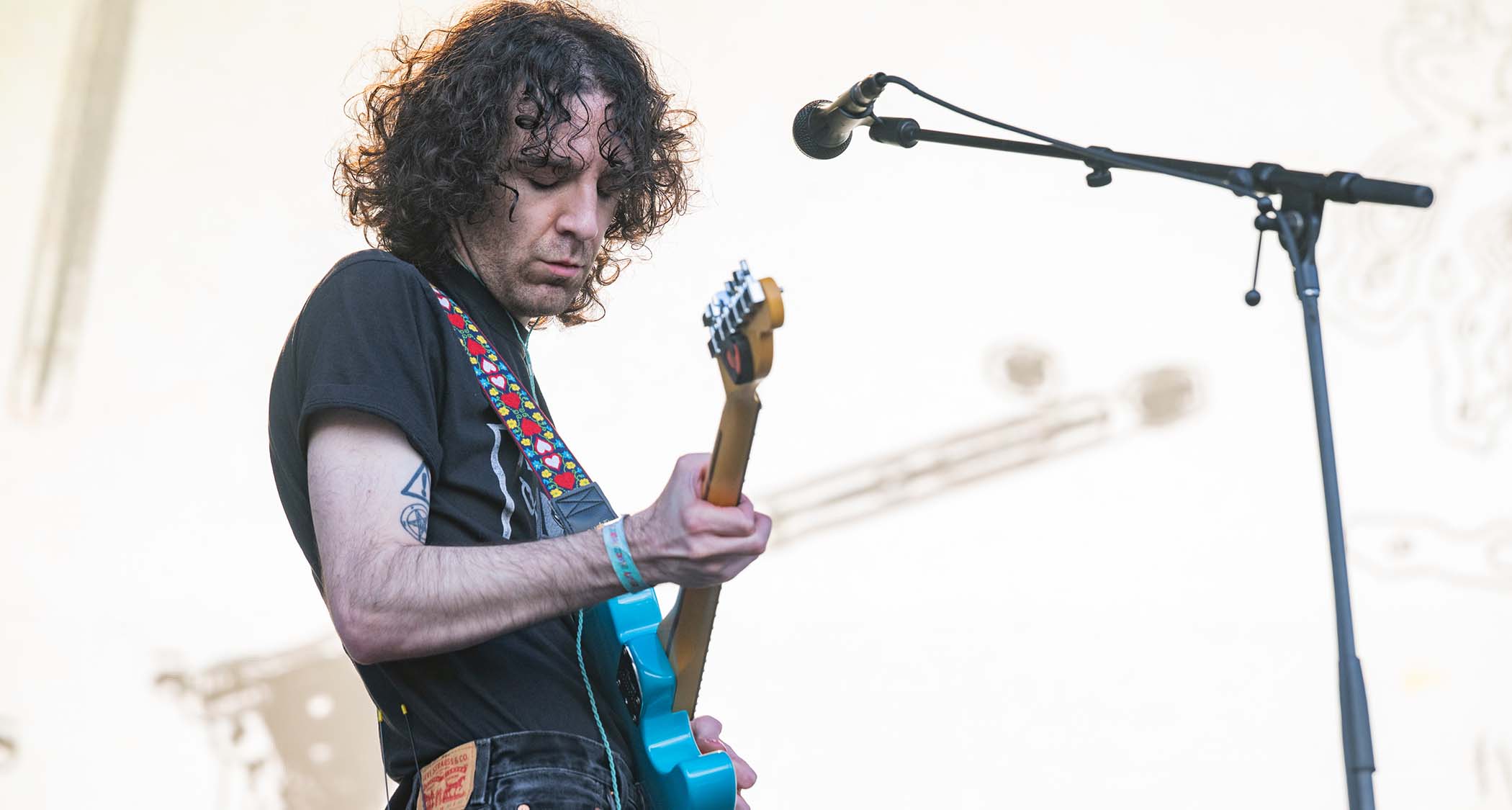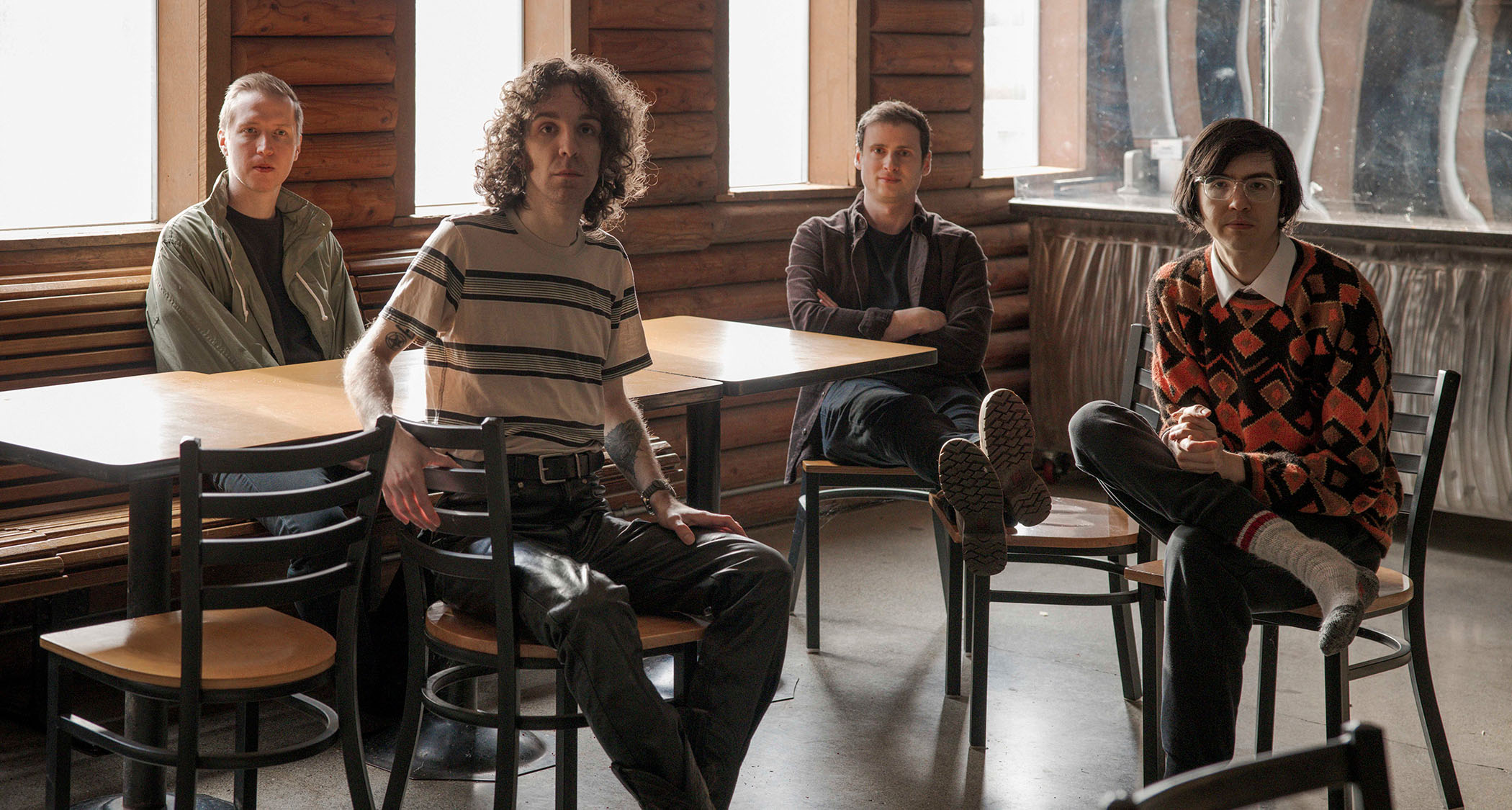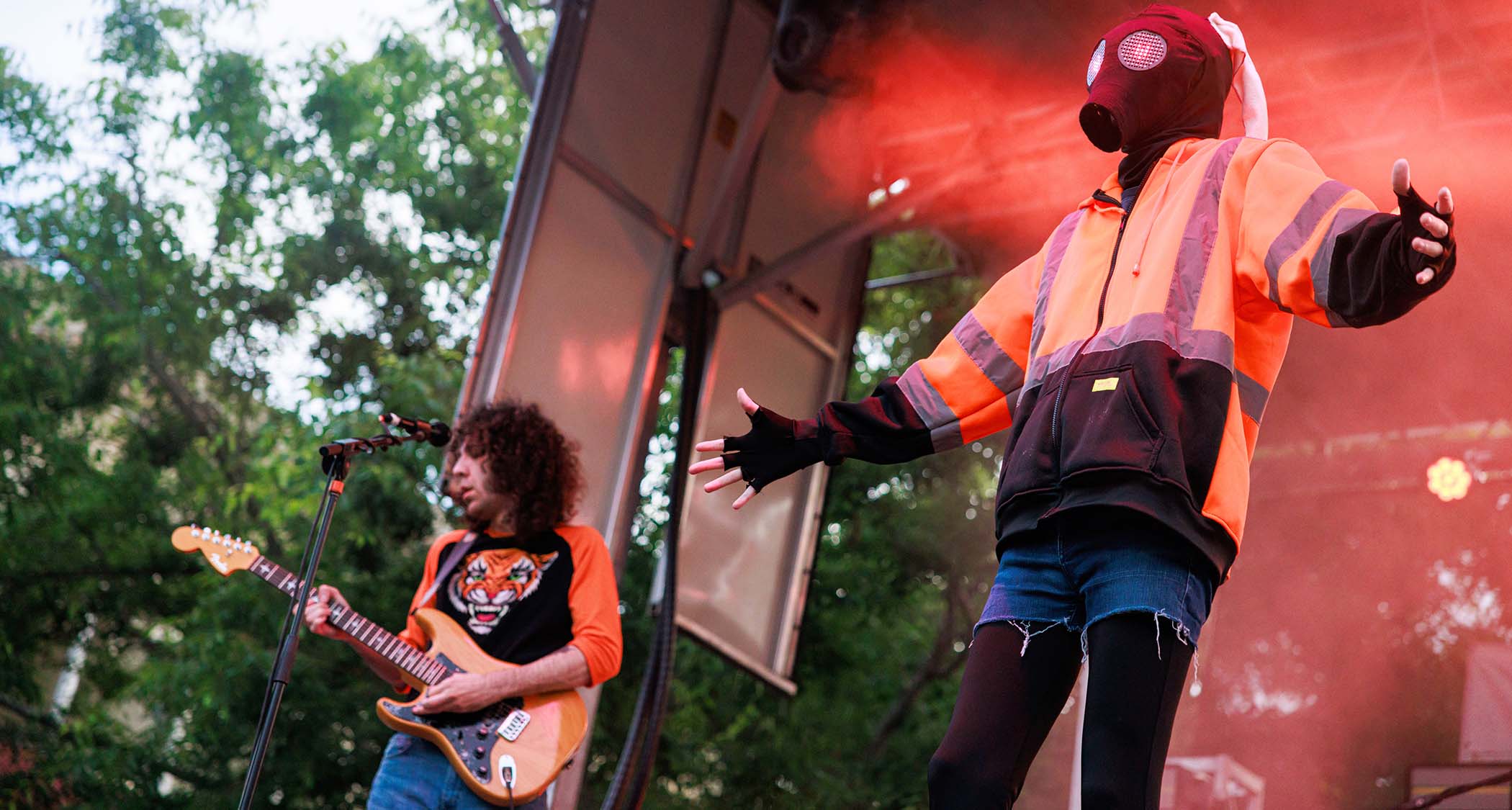“I just really needed to play this part as hard as I could, as fast as I could, or my brain would start screaming at me”: Ethan Ives on playing nasty, searching for melody and unleashing “indie Motörhead” energy on Car Seat Headrest’s epic rock opera
Ives’ playing on the Seattle indie-rocker’s audacious new album, The Scholars, is a masterclass in tone and melody, and maybe also how stylistic slipperiness is key to holding our attention

Car Seat Headrest’s latest studio album, The Scholars, is a serious trip. There’s so much music, this great agglomeration of myriad styles, tones and textures, modulations of mood and urgency. It is the kind of rock opera they only made in the ‘70s. In 2025, to preside upon an album of such scope, feels like an audacious act of pop-cultural subversion.
Car Seat Headrest frontman, producer and multi-instrumentalist Will Toledo has spoken about how his health complications post-Covid have left him spending more time in his head, turning his thoughts over and over, searching for spiritual renewal.
The Scholars is the sound of Toledo letting his imagination running wild through the halls and grounds of the fictional Parnassus University in search of characters and stories. Their narrative drives the music along. You could see Wes Anderson adapting this phantasmagoric campus rumpus for the screen. Maybe one day he will.
Today, however, lead guitarist Ethan Ives is going to explain how this record came together, and what makes it different to the ür-concept albums of yore, Tommy, The Wall et al.
Where The Wall feels so monolithic and structured, there is a playful anarchy to The Scholars. Ives says it all started with Toledo getting them together, sharing his idea for the structure and the characters. They could find the narrative after the fact.
“It’s like everyone is jamming on the material, and everyone is so high on acid they’re like, ‘Wait a minute! I can see a story here!’” laughs Ives. “It was more like, ‘What songs sound good and how can we then make that work within the structure?’
It was really, really fun in a nerdy way to take each individual song as this puzzle, like, ‘Okay, would this tone and texture be good for this song? Would a Killing Joke texture be good
“It wasn’t a really rigid thing, sort of like The Wall where you have points A, B and C, and you need to hit these marks for the narrative to work. That’s the type of concept record that I like, where it’s not super linear or rigid. It’s more of a thematic connection than it is a plot connection.”
Want all the hottest music and gear news, reviews, deals, features and more, direct to your inbox? Sign up here.
At Toledo’s request, The Scholars record saw Ives take on more responsibility, skippering the sound design of the record, steering the guitars. It was a task he didn’t take lightly – even if his search for the acme of cocked-wah electric guitar tone near drove everyone mad.
“The whole dynamic around this album was really cool because previously the material would come to me more fully formed,” says Ives. “I would interpret the parts, and I would add my own flourishes, but things were more programmatically set beforehand on previous Car Seat albums.
“On this one, because I was able to come into it at a much earlier point in the writing, and things were more soft, less hard set, it really gave me a lot more freedom and wiggle room – especially with the character-centric, short-stories structure – to take every song a discrete sandbox that could have its own kind of mini-flavour or style.”

That’s how we end up with a record that’s got Devereaux with its Elliot Easton-style eighth-note powerchords, Equals with its Ronnie Wood and Rod Stewart energy, and Car Seat Headrest going full-bore “indie Motörhead" on the impeccably titled The Catastrophe (Good Luck With That, Man).
Each song keeps those styles coming. The record’s story is that of the Parnassus alumni. The story of the record is how far musical curiosity can take you when you commit to it.
The Scholars is both exhilarating and overwhelming. There are so many mood changes, little melodies catching us off-guard. Is that something you’re conscious of, changing the emotional tenor of the song on a dime?
“Thanks. I really appreciate that. That’s a part of guitar playing and arrangement that I think a lot about, and so I am always like really gratified when people pick up on that or are digging that. I’m a big guitar nerd. I’m a big rock nerd. I definitely have a Rolodex in my head of different flavours and shades, and pigments that have stood out to me.
“It was really, really fun in a nerdy way to take each individual song as this puzzle, like, ‘Okay, would this tone and texture be good for this song? Would a Killing Joke texture be good for this song? Would a Dick Dale or Omar Khorshid surf guitar style be good for the song? What type of different gain structure… Different types of EQ, chorus? How can I design the guitar palette of each song to be unique to that character, or unique to that emotion that is in that one song?’”
How finished was it when you got to the studio and how much did you change during the sessions?
“There were whole versions of songs that we would actually get to a pretty much finished state in the studio, and then we would be like, ‘ah, something about this isn’t working,’ and we’d record the whole thing again.
“I would try a different texture and sometimes that process could be really gruelling, especially when you’re doing layer after layer after layer of overdubs. And each overdub has to be like, ‘Okay, even below the main mood of this song, what is the sub-flavour of this one?’ So you can see how that could get pretty exhausting, but on a pure tone nerd level it definitely gave me a lot of steak to chew on.”

Where does your melodic sensibility come from?
People often have to tell me to like pull it back because sometimes I’ll just go too far, but I will try to phrase things in a way that is melodically intriguing
“Like a lot of guitar players, I have a very short attention span. Overwhelmingly, my instinct around guitar has really just been, if a part isn’t holding my attention, I change it, and if it’s still not holding my attention, I change it again, and if a part felt good before and then it stops feeling good, I change it again.
“People often have to tell me to like pull it back because sometimes I’ll just go too far, but I will try to phrase things in a way that is melodically intriguing to me.
“Or if the part is very very diatonic and very straight major scale, sometimes I will compulsively need to throw some kind of weird counter-scale onto that, or some kind of other weird melodic flavour that maybe even doesn’t feel right for the song but I just have to get it out of my system. I’m like, ‘Okay, well at least I exorcised the demon. I played melodic minor over that for one second!’”
You’ve got to try it. Otherwise you’ll listen back and thing “What if?”
“Right! What if that was the sound!? Yeah.”

But guitar playing is a process like that. You learn by doing.
“I used to have a lot of problems with intonation and tuning stability because I didn’t have any velocity control. I was just such a violent player because my brains just really needed that direct contact, and that kind of ADHD.
“I just really needed to play this part as hard as I could, as fast as I could, or my brain would start screaming at me. And so it’s been a long process of using those instincts – because they’re useful – but then also reining them in where they’re not getting in my way as much as a player.”
So you’ve changed your style?
“I’ve learned to have a softer hand and maybe be a little bit more dynamic about my playing. But definitely in terms of writing parts, I try to use that attention span fickleness, to leverage that to my advantage where I can use that as an engine for not always just being happy with the part because it sounds okay [but] trying to really hammer everything until it feels really interesting to me.”
That’s so relatable that idea of playing hard. It’s almost like a discipline thing, learning to trust the gear.
The audience will not get bored if you’re not, like, absolutely thrashing the guitar on the quietest song in the set
“I’ve been learning a lot more in the last few years about how gain staging is not just about the output level, it’s also the way and the threshold at which your amp starts to break up. It gets into a very physical level where it’s like you kind of set the gain staging up to where you feel comfortable pick-attacking.
“You set it up for the pick velocity that you physically feel comfortable with. Some players I know that have a really heavy hand, they’ll set their amp up so that the perfect breakup threshold is that really hard strumming level because that’s their baseline of how they like to pick.
“It’s just funny how physical that gets, where it is really about you setting it to where your arm feels comfortable hitting. But I have had to kind of teach myself over the years, just through Pavlovian conditioning, like, ‘Okay! You don’t have to hit every single part at maximum velocity!’ [Laughs] The audience will not get bored if you’re not, like, absolutely thrashing the guitar on the quietest song in the set.”
That’s what the acoustic guitars are there for. You thrash a lot of acoustics on this. Did you use your Wechter?
“No. It’s funny, I was going to use my Wechter on all those tracks but I feel like I ended up sneaking in a lot of 12-string onto the album, not really by design but because my Wechter was all out of whack for the recording sessions. It had not been set up in four or five years, and it was just in really bad shape.
“I ended up using my Martin – not like the really nice Martins but one of the more affordable ones because that was the only acoustic I had, and ended up being really happy with it. I’ve actually gotten really, really into 12 strings in the last couple of years.
“They’re perfectly set up for somebody like me, where they benefit from really aggressive playing because they are more more demanding on your on your hands.”

Tell us about The Catastrophe (Good Luck With That, Man). It sounds like you should be wearing a cape performing that one. It’s a great track.
“Thanks, man! For me, that was the climax of the guitar tracking. That was the most high-energy guitar tracking that we did, and most of the guitar layers on that song that you were hearing are are in one continuous take.
“That one I played pretty much everything all the way through, so the energy that you’re hearing, even where it starts to drag, the part starts to lag behind the beat a little bit, it’s because my arm just like getting so worked out throughout the song. [Laughs]

“That was a great cathartic song for me just because that one just let me work all my energy out and do all the really tough stutter picking that I like doing. I’m trying to remember how most of the parts came about. Will came up with a lot of the basic riffs in that, then I just tried to take it and set it up to be as kind of mean and nasty as possible within the framework of the song.
“It’s not necessarily meant to be a nasty song but that’s how I wanted to play it where it has got this kind of spittle-y, dirty slapback on it, and that kind of almost Pixies-style of really, really kinetic strumming.”
It has Motörhead energy.
“It’s like indie Motörhead! [Laughs]”
Then you follow that with Equals, which opens with this laid back almost ESG-style beat, then goes into a sort of Rod Stewart/Ronnie Woods jam – it makes me think of Ooh La La by the Faces
“I find this when I’m writing. I can’t stay on one thing too long or I get sick of it, so being able to jump around different styles, and even different eras of rock music, really helps me stay on track, because it makes me feel like I’m always doing something new, and I am not getting sick of anything.
“Definitely on that song there was a lot of fun stuff to play with, starting with a Gilmore-esque rotary effect to set the mood at the beginning, and later on to some quintessential Vox jangle-y, Radiohead-y stuff, like pick an open chord and dance around it with some fun strumming patterns.
“Those were the things I was trying to work with on that song. It was nice to have these huge energy shifts between songs where you could really just feel like you were doing something really novel – at least to me in the studio – rather than just hammering away on the same thing.”

You are very open about sharing these sonic references. Some players get quite guarded about that kind of thing. But they are essential. It’s like the periodic table, a vocabulary of sounds.
If I’m listening to something, and it just feels like it’s almost like it is just talking about stuff outside of the song, that can definitely pull me out of the feeling of that song
“Definitely for writing, it is true what you say about reference points and stylistic references in art. References to other artists are a very useful language for talking about songwriting ideas, or tonal ideas, and things like that.
“And it’s definitely a really fine line, right? Like, I do think there is a tendency sometimes to be overly meta-textual or overly referential – that takes me out of a song. If I’m listening to something, and it just feels like it’s almost like it is just talking about stuff outside of the song, that can definitely pull me out of the feeling of that song.
“I think it’s something that is better used behind the scenes, while you’re working on a song, and you definitely don’t wanna get into the area of being overly imitative. I really like using those kinds of templates as a starting point, but if I decide on a song, ‘Okay, I’m gonna do a Gilmore thing’, I always try to use that as a vehicle to get to where I want to go on a song, and not just be happy with ‘Okay, I’ll just do what Gilmore does.’ Not that I could ever play as well as him.”
Devereaux, with those eighth-note powerchords makes me think of the Cars. What were you using on that?
“That was one where I actually got called out a little bit in the studio, where I was trying out these very, very minute kinds of cocked-wah sounds, EQ pushing a really, really narrow band in the mid-frequencies.
What I was trying to do was get a Marc Bolan treble-booster sound, where it’s like really nasally
“What I was trying to do was get a Marc Bolan treble-booster sound, where it’s like really nasally, and there’d be times when I would get an entire rhythm take – and it would feel like I’d played it really well – and then we would go back and listen to it and everyone would be like, ‘The frequency that it was set to is annoying!’ So we’d have to go, change it by like 100Hz and then go back and do it again.”
Pop-culture is a little too knowing these days. Of course we can hear sonic references across The Scholars but there’s a playfulness to the whole thing.
“That’s great. That makes me really happy. It was this innocent thing. We weren’t thinking about it that much when we were making the album. We tried to just write in as much of a a a commercial vacuum as possible, and then just hope that, at the end of the process, like, if this sounds good to us, then there will be an audience for it.”
Did you have any gear epiphanies when making this one?
Honestly, just an American Tele into an AC15 got me almost everywhere I wanted to go
“I had never touched a Telecaster before. I didn’t think I liked them. I thought they looked silly. Then I actually got one. [It’s] just the simplicity of it but also the versatility, where it’s you have very few controls, but within those few options you can get almost anywhere you want to be.
“Honestly, just an American Tele into an [Vox] AC15 got me almost everywhere I wanted to go. I started using a Chase Bliss Automatone. I started wrangling down a lot of my gain-staging pedals into fewer pedals, but with more programmability… more MIDI capable where I could recall settings on a smaller number of pedals.
“We had some some big giant Marshall stacks on the record that were, you know, barred from the studio! I think that was the first Car Seat record where we used stuff like that heavily.”
- The Scholars is out now via Matador.
Jonathan Horsley has been writing about guitars and guitar culture since 2005, playing them since 1990, and regularly contributes to MusicRadar, Total Guitar and Guitar World. He uses Jazz III nylon picks, 10s during the week, 9s at the weekend, and shamefully still struggles with rhythm figure one of Van Halen’s Panama.
You must confirm your public display name before commenting
Please logout and then login again, you will then be prompted to enter your display name.







